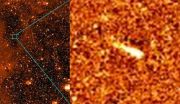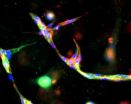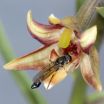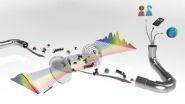(Press-News.org) In the first half of February 2009, two asteroids collided in a region of space beyond the orbit of Mars, as scientists from the Max Planck Institute for Solar System Research (MPS) in Germany have now discovered. The researchers were able to pinpoint the exact date of the impact more precisely than ever before. The debris of the crash had attracted the attention of scientists worldwide. Together with the largest earthbound telescopes and the Hubble Space Telescope, the OSIRIS camera system onboard ESA's space probe Rosetta, that was developed and is now operated under the lead of the MPS, took a close look at these remains. The space probe's unique viewpoint, combined with detailed computer simulations, allowed the scientists from the MPS to reconstruct the collision precisely. Until now, such a recent clash of two asteroids was unknown. (Nature, October 14th, 2010)
Several million large and small fragments of rock populate the so-called asteroid belt, the region of space between the orbits of Mars and Jupiter. During their journey around the Sun, time and again such asteroids collide. Due to the immense expansion of the asteroid belt, most of these incidents are not discovered. Major collisions that happened thousands to millions of years ago have been inferred from the presence of diffuse bands of dust spreading across the whole sky, and families of asteroids with similar orbits. Most of what scientists know about collisions between asteroids comes from the study of these fossilized remains, a sort of space paleontology.
"In comparison, it was practically yesterday that the asteroid named P/2010 A2 bumped into a small rock with a diameter of only a few metres", says Dr. Colin Snodgrass from MPS. The trail of debris from the collision is still directly visible to astronomers with large telescopes, and scientists have been excited to be able to study it in detail. "Imagine finding a fresh dinosaur body instead of having to figure out how they looked from fossils", adds Snodgrass.
In January 2010, scientists working on the LINEAR project (LIncoln Near-Earth Asteroid Research) stumbled across the asteroid P/2010 A2 during routine scans for asteroids near Earth. Because of its appearance, scientists initially believed the cosmic chunk to be a comet - and gave it a name based on the common cometary nomenclature. In the following months, however, more precise studies revealed its true nature.
Crucial for the right classification is the shape of the trail of debris and its evolution in time. "In order to judge both, the perspective is extremely important", explains Snodgrass. Since the orbits of Earth and the asteroid lie nearly within the same plane, all pictures taken from Earth show only a projection of the trail. From this point of view it is therefore difficult to discern its true length and shape. This constriction also holds true for the powerful Hubble Space Telescope, since - compared to cosmic distances - it circles Earth in close proximity. Only the Rosetta space probe, which was well beyond the orbit of Mars when it observed the trail in March 2010, experienced a completely different view: The orbits of Rosetta and the asteroid are tilted with respect to each other.
The situation can be compared to watching a locomotive approaching frontally. From this perspective, it is difficult to estimate the length of the row of cars attached. Only when changing the location, for example to a point further above the train, can the whole length of the train be seen.
"With the help of the images from Rosetta we could see the true three dimensional shape of the trail", says Snodgrass. This shape is not typical for a comet continuously emitting material and points to the trail of debris due to a collision of asteroids. Together with further images taken from Earth, these pictures allowed the researchers from MPS to reconstruct exactly how the trail had evolved in time. They fed their computer program with an initial assumption about the size of the currently visible grains of debris. In a next step they calculated how the distribution of these grains evolves in time. "By comparing these results with the actual distribution, the assumption for the size can be refined step by step - until the exact reconstruction is found", explains Dr. Jean-Baptiste Vincent from MPS, who performed the simulations.
With their method, the scientists from MPS could pinpoint the date of the collision to a window of ten days around February 10th, 2009. The size of the grains of debris they calculated to be at least one millimetre. In addition, these calculations offer a unique understanding of the initial phase after a collision of two asteroids.
In addition to being of scientific interest, the result is a significant technical accomplishment for the Rosetta spacecraft. The dust trail is so faint that the largest ground based telescopes (with apertures of up to ten metres) and the Hubble Space Telescope were used to observe it from Earth. The OSIRIS camera is around 7000 times less powerful than the biggest ground based telescopes. "The OSIRIS camera is more like a telephoto lens than a telescope, it is designed to take detailed images of a comet from close range", explains Dr. Cecilia Tubiana, who led the processing of the images from Rosetta at MPS. "Although far from Earth, Rosetta was still millions of kilometres from the P/2010 A2 collision, and the debris trail appeared as a very faint streak against the background stars", adds Dr. Holger Sierks, principle Investigator of the OSIRIS-Team. Careful combination of four hours worth of images was required to make this observation.
ESA's space craft Rosetta has been on its way to the comet Churyumov-Gerasimenko since 2004. Rosetta will reach its destination in 2014. The scientific camera system on board called OSIRIS was developed and built at MPS. In July, OSIRIS took detailed images of the asteroid Lutetia during flyby.
INFORMATION:
Original work:
Colin Snodgrass et al.
A collision in 2009 as the origin of the debris trail of asteroid P/2010 A2
Nature, October 14th, 2010
Asteroid collision forensics
2010-10-15
ELSE PRESS RELEASES FROM THIS DATE:
New research helps clinicians predict treatment outcomes for children with OCD
2010-10-15
VIDEO:
New research from the Bradley Hasbro Children's Research Center may help clinicians better predict how a child with obsessive compulsive disorder (OCD) will respond to some of the most commonly...
Click here for more information.
EAST PROVIDENCE, RI – New research from the Bradley Hasbro Children's Research Center may help clinicians better predict how a child with obsessive compulsive disorder (OCD) will respond to some of the most commonly used treatment approaches. ...
University of East Anglia makes cancer breakthrough
2010-10-15
Scientists at the University of East Anglia have made an important breakthrough in the way anti-cancer drugs are tested.
A tumour cannot grow to a large size or spread until it has developed its own blood supply and leading research has looked for a way of halting capillary formation to stop tumours taking hold.
But new findings published today in the Journal of Cell Science have shown that scientists testing such treatments may not have been studying exactly what they thought they were.
The research proves that cells are able to switch their genetic profile – ...
OCTANE study influences revision of WHO guidelines for treating some HIV-infected women
2010-10-15
Findings from a study, which appear in the Oct. 14, 2010 New England Journal of Medicine, helped influence the World Health Organization (WHO) to change its guidelines this year for the treatment of HIV-infected women who receive a single dose of the antiretroviral drug nevirapine to prevent HIV transmission to their babies. The study demonstrated that the single dose of nevirapine used to prevent mother-to-child transmission of HIV can hamper the drug's effectiveness if it is also used later as part of a regimen to treat these same individuals.
The Phase III study, called ...
Biomarker shows potential for early diagnosis of lung cancer
2010-10-15
CHAPEL HILL, NC – A collaboration between physicians and scientists at UNC Lineberger Comprehensive Cancer Center and the University of Texas M.D. Anderson Cancer Center has demonstrated that a biomarker called TCF21 may be used to develop a potential screening test for early-stage lung cancer.
Despite the fact that lung cancer is the leading cause of cancer deaths worldwide, early-stage lung cancer is difficult to diagnose. A number of proposed screening tests, including screening CT scans and serum markers, have not shown any benefit in enhancing patient survival.
TCF21 ...
Not all doctors follow cancer screening guidelines
2010-10-15
Only one-fifth of primary care physicians in the US follow practice guidelines for colorectal cancer screening for all the tests they recommend, according to Dr. Robin Yabroff from the National Cancer Institute and her colleagues. About 40 percent followed guidelines for some of the tests they recommended and the remaining 40 percent did not follow guidelines for any of the screening tests they recommended. Furthermore, their analysis1 of physician screening recommendations for colorectal cancer shows that many clinicians either overuse or underuse screening. Their findings ...
Orchid tricks hoverflies
2010-10-15
Even Darwin was a self-admitted orchid lover. Dictionaries describe orchids as exotic ornamentals. Indeed, these plants – more than 30000 different species are thought to exist – are exotic due their extraordinary and diverse flower morphology. However, they are also exotic from a point of view other than beauty: as crafty imposters in order to achieve reproduction and to make sure that their ovaries are pollinated. Orchids depend on the assistance of pollinators, and like many other flowering plants, attract insects.
Epipactis veratrifolia, an orchid native in South ...
The kids are all right: Few negative associations with moms' return to work after having children
2010-10-15
WASHINGTON – Children whose mothers return to work before their offspring turn 3 are no more likely to have academic or behavioral problems than kids whose mothers stay at home, according to a review of 50 years of research.
"Overall, I think this shows women who go back to work soon after they have their children should not be too concerned about the effects their employment has on their children's long-term well-being," said psychologist Rachel Lucas-Thompson, PhD, lead author of the study conducted with Drs. JoAnn Prause and Wendy Goldberg at the University of California, ...
Study: Belief in rumors about proposed NYC mosque linked to opposition to all mosques
2010-10-15
COLUMBUS, Ohio – People who believe false rumors about the proposed Islamic cultural center and mosque near Ground Zero in New York City not only are more likely to oppose that project – they are more likely to oppose building of a mosque in their own neighborhood.
Researchers surveyed 750 Americans and asked them if they believed any of four rumors associated with the New York City mosque, all of which have been refuted. One of the rumors, for example, falsely says that that the proposed center is scheduled to open on September 11, 2011 in celebration of the 10-year ...
Large gaps found in public understanding of climate change
2010-10-15
New Haven, Conn.—Sixty-three percent of Americans believe that global warming is happening, but many do not understand why, according to a national study conducted by researchers at Yale University.
The report titled "Americans' Knowledge of Climate Change" found that only 57 percent know what the greenhouse effect is, only 45 percent of Americans understand that carbon dioxide traps heat from the Earth's surface, and just 50 percent understand that global warming is caused mostly by human activities. Large majorities incorrectly think that the hole in the ozone layer ...
JILA unveils improved 'molecular fingerprinting' for trace gas detection
2010-10-15
Scientists at JILA and collaborators have demonstrated an improved laser-based "molecular fingerprinting" technique that picks out traces of key hydrogen-containing and other molecules from a billion other particles in a gas in just 30 seconds or less—performance suitable for breathalyzers for diagnosing disease, measuring trace gases in the atmosphere, detecting security threats and other applications.
JILA is jointly operated by the National Institute of Standards and Technology (NIST) and University of Colorado at Boulder (CU).
Described in Optics Express,* the research ...




